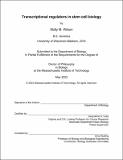| dc.description.abstract | Adult stem cells support tissue regeneration by both self-renewing and differentiating into specialized cell types. Analogous self-renewal and differentiation processes enable cancer stem cells to promote tumorigenesis. Transcriptional modulation, enacted by proteins including epigenetic regulators and transcription factors, determines cell fate. However, the functions of transcriptional regulators of stemness may differ in normal and transformed cells. In this thesis, I describe two transcriptional regulators of stemness and their deployment in adult stem cells and cancer. The first study focuses on the epigenetic regulator B-cell-specific Moloney murine leukemia virus integration site 1 (BMI1). BMI1 promotes stemness and tumorigenesis in many tissues through both transcriptional repression of the Cdkn2a locus and other functions. Notably, BMI1 supports melanoma progression by activating epithelial-mesenchymal transition (EMT) programs, suggesting that its role in melanocytes may also be Cdkn2a-independent. We show that BMI1 is required for melanocyte stem cell (MeSC) maintenance and function. RNAsequencing of MeSCs established that BMI1 loss leads to derepression of Cdkn2a and developmental transcription factor genes. Additionally, we observe downregulation of glutathione S-transferases, suggesting that reactive oxygen species (ROS) may accumulate in melanocyte lineage cells in the absence of BMI1. Antioxidant treatment in mice partially rescued melanocytes, indicating that BMI1-dependent ROS homeostasis may support melanocyte expansion. These data demonstrate that BMI1 has unique functions in MeSC biology that contrast with its role in melanoma. In the second study, we identify the transcription factor GLI-similar 2 (GLIS2) as a regulator of mammary stem cell (MaSC) differentiation. In the mammary epithelium, EMT drives formation of primary cilia, which promote MaSC self-renewal. We showed that primary cilia enable MaSC function in part through inhibiting GLIS2. Glis2 deletion in mice led to MaSC expansion and increased self-renewal. Conversely, GLIS2 hyperactivity in mammary cells suppressed stemness and tumorigenesis. Furthermore, human claudin-low breast cancer cells form primary cilia, and sequencing experiments demonstrated that GLIS2 is inactive in claudin-low breast tumors, indicating that GLIS2 regulation is relevant to normal and transformed mammary cells. Collectively, this work highlights roles for transcriptional regulators in self-renewing cells and elucidates how stem cell program activation induces context-dependent molecular consequences in normal and transformed tissues. | |
